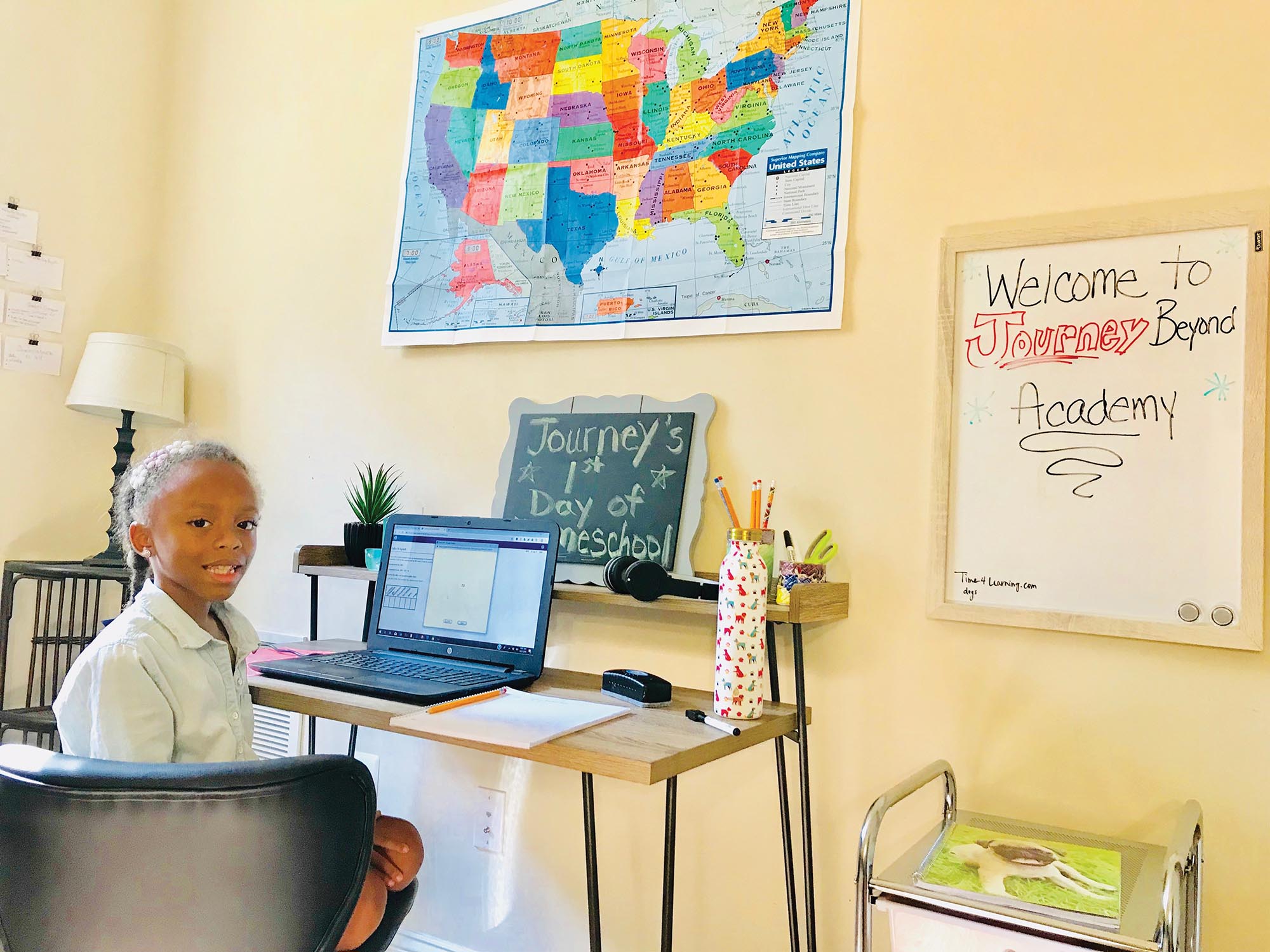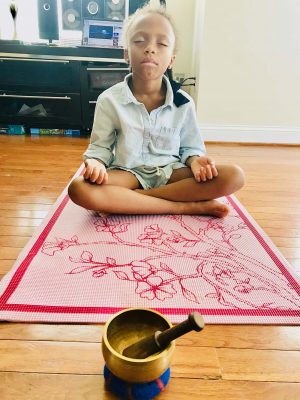HOW A LOCAL CHILDREN’S AUTHOR IS BALANCING WORK & AT-HOME SCHOOLING
Virginia children’s book author Marc Boston moved to Charlottesville from Kansas City, in part, to immerse himself in this city’s strong writing community. A stay-at-home dad and lifelong book lover, Boston enjoyed bedtime stories as much as his three young daughters. But when they noticed how few books featured people of color, he says he “felt compelled to act. His mission is to create stories that emphasize the importance of diversity and inclusion and reflect on topics surrounding our own definition of family values and self-empowerment.

How have you set up your child’s learning space?
The first factor we considered is their study and learning style. One of our children can get distracted at times, and we found it best to set up a comfortable and quiet, out-of-the-way space that limits interruptions. Our older two are more independent learners who have assisted in creating a cozy space for themselves at desks—one in her room and one in the office.
How often do your daughters take a break and how do they use that time?
Our kids, who are all middle school age now, can focus on their virtual learning activities for about 40–45 minutes or so before their eyes begin to glaze over and they start doing their all-too-familiar fidgety chair dance. Typically, a 10–15 minute break will re-center them. If it’s nice out, we’ll take a quick outside break for fresh air and toss the ball around or entertain their new puppy.
How do you motivate the kids when they may not want to do their work?
We’ve found that positive reinforcement works best to keep our children engaged and motivated, and we tend to reward effort over outcome.
If we note that they are not immediately motivated to get schoolwork completed, we tend to make space for them to decide when it will be a good time for them to come back to it later, and allow them to pick a particular subject or activity they would be more interested in tackling at moment. We’ve found that allowing them to have some choice in determining when to get homework completed minimized the drama. It may look different day-to-day, but we’re okay with that. Plus, tons of hugs, high-fives and hurrahs for their effort go a long way toward keeping them lively and focused … and a little ice cream never hurts either.
How do you connect your child’s learning to real-world experiences?
Combining academic learning with real-world experiences is paramount, and should be the true purpose of a child’s well-rounded education in our book. We are believers that schooling and parenting should work in harmony to prepare our children for real-world experiences, and this can occur with as much experiential learning outside of the four walls as possible. This can be achieved through field trips, public service opportunities, and by encouraging them and allowing them the freedom and space to discover their own ways of being productive.
Additionally, their current age and stage of development now incorporates more academic learning into subjects that would prove challenging to discuss without touching on current events and learning to be good global citizens. Not that school indoctrination should teach kids what to think or believe, but more so equip them with the tools and skills to think critically, to recognize and learn to respect perspectives, and to learn how to cope with change, which is a constant in life.
Do you have any technology dos and don’ts?
We live in an age where the use of technology is almost unavoidable, so guiding our children and teaching them to use it in a healthy way is key! In life, we should all seek balance in everything we do—what we think, how we feel, what we eat, what we say. All of this requires a certain amount of awareness. It’s really easy to allow our children to sit on their phones or ipads, but I think we can all agree this isn’t in their best interest. It’s not in our best interest as parents either, and that’s why we try hard to model the behavior we wish our children to emulate, which admittedly, can be hard sometimes. In our home during the school year, we don’t allow any electronics Monday–Friday until all homework and extracurricular activities are completed. Even then, we set and attempt to enforce a one-hour limit. The rules are more relaxed on weekends and summer break. We’ve found that when we set limits and keep it consistent, our kids have begun to self-regulate.
How do you balance working at home with schooling at home?
There are many challenges to at-home schooling, but this one may be the toughest. Setting a schedule and establishing a routine helps to keep the ship afloat, for school as well as mealtimes, free time, chores, getting outdoors, and taking a quiet moment to center. When they are working, I am working. Even though I’ve now been required to set up my workspace near my youngest so I can offer assistance when needed has transformed our experience into a tidy and tremendously tolerable one.

How do you handle snacks and meals to keep it easy?
We do our best to plan our meals for the week ahead of time. My wife oftentimes has the menu completed so we don’t have to put a lot of thought into it or waste too much time trying to figure out what to eat, which also reduces a considerable amount of stress. We do our best to have the things we need on hand so that meals can be made quickly and conveniently.
How do you incorporate fitness and out of doors into your school days?
Our family has always been very active, and being outdoors is a major part of our lifestyle. For years, we have enjoyed daily family walks as circumstances allow; and now with a new puppy, our time outside has increased. Just because our students are learning from home doesn’t mean we get to skip out on the importance of physical fitness. Each day, we engage in structured PE together like jumping jacks, crunches and stretching. I do the exercises with them, because for one, I’m not getting any younger, and two, it’s more fun!
What advantages have you found to at-home schooling?
One of the most beautiful advantages of at-home schooling is the scheduling and academic flexibility it provides. Academically, we can move at our own pace and focus on subjects as much or as little as needed. Although the girls perform the same morning routine as if they are actually going to school, such as getting dressed, making beds, etc., we do enjoy less of the hustle and bustle of having to leave the house by a certain time. And, we are enjoying the convenience and efficiency of learning in the warm, familiar and friendly confines of our own home.
 How do you suggest parents take learning beyond the classroom?
How do you suggest parents take learning beyond the classroom?
The wonderful thing about learning is that it can take place indoors or outdoors, in museums or churches, at markets or on hiking trails, or even alongside the rush of the Rivanna River. The places that learning can happen are basically limited to the magnitude of your imagination. Trade your desk and chairs for a picnic table or blanket under a shady tree. It’s nothing like mixing in a math lesson surrounded by the sound of birds chirping or mixing your reading lesson with a lesson in stone skipping. Your individual learning space can be anywhere or look however you choose, and it’s a great way to incorporate experiential or real-world learning into your program.
What other advice do you have for parents who are now managing the new world of at-home school?
I recommend for parents to just find their own groove and to decide what works best for them and their family. Experiment with a few things, and take it one day at a time. It’s easy to feel overwhelmed at times with so many moving pieces that we are all trying to balance, which is normal.
It’s helpful to find a practice or a productive way to help alleviate this strain. For me, it’s my daily mindfulness and mediation practice.
It may also be beneficial to connect with other parents to establish a support system, because we are all in this together. I know of several parenting groups that offer this type of support, be it sharing useful homework advice, establishing pod groups, providing updates on school and community ongoings, or just sharing stories of successes and failures through this journey that we are all currently walking.
What websites do you like and use with your daughters?
We use a variety of websites and streaming apps to incorporate family learning whenever possible. We often watch the show “Planet Earth,” and we use Google Earth to identify places of interest. We cue up relevant documentaries to support current lessons or to expand knowledge, and we’re constantly researching interests that may come up at any moment. For example, we just adopted a new puppy into the family, which the girls have been researching for years to ensure that we were well prepared to care for our newest furry family addition.
Is there a book you recommend for parents right now?
Kelly Crawford’s book Think Outside the Classroom: A Practical Approach to Relaxed Homeschooling: A closer look at what an education really is and how to implement it in a relaxed, homeschooling style.
is a University of Virginia student and a Charlottesville local who is dedicated to making her community a better place. She also enjoys exploring and writing about all that Virginia has to offer.
YOU MIGHT LIKE



